Gust Post by Will Ellis
Your emergency shelter should always suit your situation.
Cold weather? Ample insulation
. Heavy rain? Deflect it.
Sun? Sometimes, you need two whole roofs to fight it.
These 8 simple shelters can help anyone conquer the great outdoors - no matter the environment.
Survival Shelters for Rain Protection
1. Lean-To
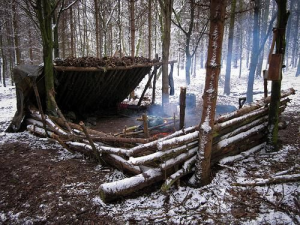
Quick and simple, a lean-to can be built in less than a hour out of practically anything, which makes it a very attractive structure in a survival situation.
How to Build:
Wedge a sturdy pole between two trees. Layer one side of this pole with smaller branches and sticks. Cover this side with leaf litter, brush, grasses, palm fronds, or any other vegetation you can see.
Be Aware:
A lean-to has very little insulation and often becomes obsolete if the wind changes direction. Adding a second side is an excellent way to combat this issue.
2. A-Frame Tarp
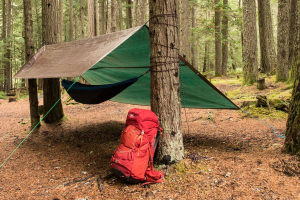
Looking for a versatile shelter that can go up in less than ten minutes? The A-frame tarp is the way to go.
How to Build:
Suspend a cord between two supports; higher for more airflow, lower for better rain coverage. Lay tarp over the cord and secure all four corners and set up
your survival hammock underneath the tarp.
Bonus tip: the cord that connects the tarp and the tree is a great place to hang any
self defense shotgun or rifle, and makes for easy access should you encounter unwanted predators in the night.
Be Aware:
You can use a poncho or waterproofed canvas instead of a tarp. This works very well with a hammock or over a bough bed.
Survival Shelters for Sun Protection
 3. "Double Roofed" Desert Tarp System
3. "Double Roofed" Desert Tarp System
Centuries of use throughout the deserts of northern Africa and the Middle East (and more recent trials in military survival training) have proven that the double roofed tarp is the best structure to block out the sun. A
side awning built with modern material may do a better job of blocking the elements, but both are capable of blocking the hot sun.
How to Build:
Replace or dig a low spot, roughly 18 inches or so, into the ground. Lay one tarp over the low spot and drive one stake through each corner.
Tightly tie this tarp to the stakes. Attach the second tarp a foot above the first. Tie the tops of the stakes to anchors, which can be rocks, other stakes, logs, or any sturdy object.
Be Aware:
You can also fold over a single tarp in order to create the two layers, so long as there is still one foot of airspace between the layers when attached to the stakes.
4. Ramada
If airflow and shade is more of what you're looking for, a ramada is well suited to your shelter needs.
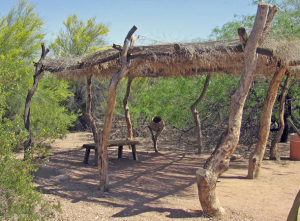 How to Build:
How to Build:
Most variations rely on four posts sunk into the ground with lightweight support beams fastened between them to create a steady structure. Layer the flat roof with brush, a tarp, or mats to provide shade.
Be Aware:
Due to the flat roof, the ramada is ill-suited to blocking rain. You can add removable walls to the structure to protect against nightly temperature drops.
Survival Shelters for Cold Weather Environments
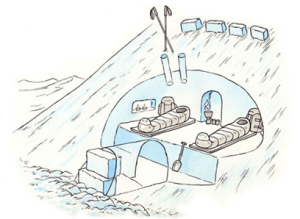 5. Snow Cave
5. Snow Cave
This kind of shelter may be your only option in an area with no vegetation and very deep snow, but can be just as dangerous as the cold.
How to Build:
Locate a deep, solid snow drift or bank and dig a tunnel into the side, leading towards a low spot. Then dig up and around, creating a sleeping shelf in the highest part of the shelter. Dig a hole roughly six inches wide in the roof for ventilation, especially if you plan to block the entrance.
Be Aware:
A snow cave can be deadly if you select the wrong type of snow. Inhabitants can die from low oxygen or get buried alive if the ceiling collapses.
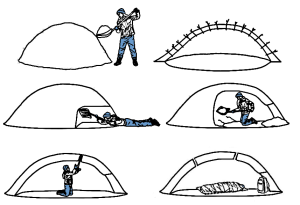
6. Quinzhee
Smaller and easier to construct than an igloo,
the quinzhee is a wonderful cold weather alternative.
How to Build:
Under a tarp, pile gear that is easy to move, like a backpack. Cover the tarp with snow, packing it down repeatedly until the snow is two feet thick all the way around, Insert 3-4 dozen 12" long sticks around the dome.
Burrow into the side to retrieve the tarp and gear. Excavate the snow from inside until you can reach the base of every stick, so the thickness is uniform. Include a ventilation hole in the roof about the size of a fist.
Be Aware:
The quinzhee can be made with almost any type of snowfall, making it very versatile.
Survival Shelters for Almost Any Environment
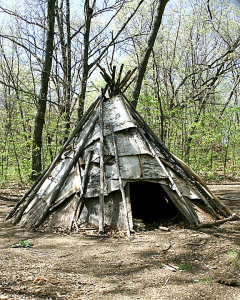
7. Round Lodge
From the prehistoric North American west to pre-Roman Britain, round lodges have long been one of humanity's preferred shelters from the wind, cold, rain, and sun.
How to Build:
Lean a dozen or more tall poles together in a clockwise fashion, then secure them at the top with rope, grass, or even sinew. Fill in the walls with vegetation - grass, hay, leaf litter, etc.
Be Aware:
Leave a hole in the roof for ventilation if you plan on having a fire.
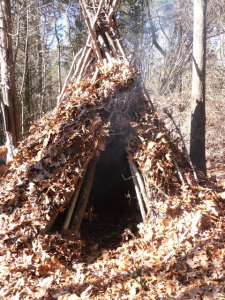 8. Wickiup
8. Wickiup
Think of a wicki-up as a tiny tipi that can be tailored to your surroundings. If built correctly, you can even light a small fire inside to keep warm.
How to Build:
Replace several dozen poles of a similar height; some will need to have forked ends. Lock those forked poles together to create a freestanding skeleton of the structure.
Lay the poles without forks around the locked forks to create walls. Fill in (or weave with) vegetation, including branches, brush, leaves, grasses, and man made materials
Be Aware:
For hot, dry climates you will want to go for a broad and squat structure covered loosely with brush to provide shade and ventilation.
For climates more apt to rain, choose thicker insulation like straw, leaves, and grass in conjunction with a steeper roof to keep you dry - but be careful to ensure it is green, if you choose to light a fire.
Conclusion
There you have it. With these 8 survival shelters, you’re ready to brave the outdoors in almost any environment. Pick one or two that look interesting and ideal for your situation, and give them a shot!
Will Ellis is the senior editor of Gun News Daily. The site was originally built by his uncle who used it as a resource center for people looking to learn more about gun education and safety. This legacy was carried on by Will, who relaunched the magazine in 2015 and began to rebuild GND. For the bulk of his career, Will worked as a private military contractor for a number of NGOs. He is currently living outside Loveland, Colorado where he runs GND and a local coffee shop. Will is also actively involved in the local community where he runs annual skeet shooting events. His favorite gun is a modified lightweight AR-15 rifle.

 Quick and simple, a lean-to can be built in less than a hour out of practically anything, which makes it a very attractive structure in a survival situation.
How to Build:
Wedge a sturdy pole between two trees. Layer one side of this pole with smaller branches and sticks. Cover this side with leaf litter, brush, grasses, palm fronds, or any other vegetation you can see.
Be Aware:
A lean-to has very little insulation and often becomes obsolete if the wind changes direction. Adding a second side is an excellent way to combat this issue.
2. A-Frame Tarp
Quick and simple, a lean-to can be built in less than a hour out of practically anything, which makes it a very attractive structure in a survival situation.
How to Build:
Wedge a sturdy pole between two trees. Layer one side of this pole with smaller branches and sticks. Cover this side with leaf litter, brush, grasses, palm fronds, or any other vegetation you can see.
Be Aware:
A lean-to has very little insulation and often becomes obsolete if the wind changes direction. Adding a second side is an excellent way to combat this issue.
2. A-Frame Tarp
 Looking for a versatile shelter that can go up in less than ten minutes? The A-frame tarp is the way to go.
How to Build:
Suspend a cord between two supports; higher for more airflow, lower for better rain coverage. Lay tarp over the cord and secure all four corners and set up your survival hammock underneath the tarp.
Bonus tip: the cord that connects the tarp and the tree is a great place to hang any self defense shotgun or rifle, and makes for easy access should you encounter unwanted predators in the night.
Be Aware:
You can use a poncho or waterproofed canvas instead of a tarp. This works very well with a hammock or over a bough bed.
Survival Shelters for Sun Protection
Looking for a versatile shelter that can go up in less than ten minutes? The A-frame tarp is the way to go.
How to Build:
Suspend a cord between two supports; higher for more airflow, lower for better rain coverage. Lay tarp over the cord and secure all four corners and set up your survival hammock underneath the tarp.
Bonus tip: the cord that connects the tarp and the tree is a great place to hang any self defense shotgun or rifle, and makes for easy access should you encounter unwanted predators in the night.
Be Aware:
You can use a poncho or waterproofed canvas instead of a tarp. This works very well with a hammock or over a bough bed.
Survival Shelters for Sun Protection
 3. "Double Roofed" Desert Tarp System
Centuries of use throughout the deserts of northern Africa and the Middle East (and more recent trials in military survival training) have proven that the double roofed tarp is the best structure to block out the sun. A side awning built with modern material may do a better job of blocking the elements, but both are capable of blocking the hot sun.
How to Build:
Replace or dig a low spot, roughly 18 inches or so, into the ground. Lay one tarp over the low spot and drive one stake through each corner.
Tightly tie this tarp to the stakes. Attach the second tarp a foot above the first. Tie the tops of the stakes to anchors, which can be rocks, other stakes, logs, or any sturdy object.
Be Aware:
You can also fold over a single tarp in order to create the two layers, so long as there is still one foot of airspace between the layers when attached to the stakes.
4. Ramada
If airflow and shade is more of what you're looking for, a ramada is well suited to your shelter needs.
3. "Double Roofed" Desert Tarp System
Centuries of use throughout the deserts of northern Africa and the Middle East (and more recent trials in military survival training) have proven that the double roofed tarp is the best structure to block out the sun. A side awning built with modern material may do a better job of blocking the elements, but both are capable of blocking the hot sun.
How to Build:
Replace or dig a low spot, roughly 18 inches or so, into the ground. Lay one tarp over the low spot and drive one stake through each corner.
Tightly tie this tarp to the stakes. Attach the second tarp a foot above the first. Tie the tops of the stakes to anchors, which can be rocks, other stakes, logs, or any sturdy object.
Be Aware:
You can also fold over a single tarp in order to create the two layers, so long as there is still one foot of airspace between the layers when attached to the stakes.
4. Ramada
If airflow and shade is more of what you're looking for, a ramada is well suited to your shelter needs.
 How to Build:
Most variations rely on four posts sunk into the ground with lightweight support beams fastened between them to create a steady structure. Layer the flat roof with brush, a tarp, or mats to provide shade.
Be Aware:
Due to the flat roof, the ramada is ill-suited to blocking rain. You can add removable walls to the structure to protect against nightly temperature drops.
Survival Shelters for Cold Weather Environments
How to Build:
Most variations rely on four posts sunk into the ground with lightweight support beams fastened between them to create a steady structure. Layer the flat roof with brush, a tarp, or mats to provide shade.
Be Aware:
Due to the flat roof, the ramada is ill-suited to blocking rain. You can add removable walls to the structure to protect against nightly temperature drops.
Survival Shelters for Cold Weather Environments
 5. Snow Cave
This kind of shelter may be your only option in an area with no vegetation and very deep snow, but can be just as dangerous as the cold.
How to Build:
Locate a deep, solid snow drift or bank and dig a tunnel into the side, leading towards a low spot. Then dig up and around, creating a sleeping shelf in the highest part of the shelter. Dig a hole roughly six inches wide in the roof for ventilation, especially if you plan to block the entrance.
Be Aware:
A snow cave can be deadly if you select the wrong type of snow. Inhabitants can die from low oxygen or get buried alive if the ceiling collapses.
5. Snow Cave
This kind of shelter may be your only option in an area with no vegetation and very deep snow, but can be just as dangerous as the cold.
How to Build:
Locate a deep, solid snow drift or bank and dig a tunnel into the side, leading towards a low spot. Then dig up and around, creating a sleeping shelf in the highest part of the shelter. Dig a hole roughly six inches wide in the roof for ventilation, especially if you plan to block the entrance.
Be Aware:
A snow cave can be deadly if you select the wrong type of snow. Inhabitants can die from low oxygen or get buried alive if the ceiling collapses.
 6. Quinzhee
Smaller and easier to construct than an igloo, the quinzhee is a wonderful cold weather alternative.
How to Build:
Under a tarp, pile gear that is easy to move, like a backpack. Cover the tarp with snow, packing it down repeatedly until the snow is two feet thick all the way around, Insert 3-4 dozen 12" long sticks around the dome.
Burrow into the side to retrieve the tarp and gear. Excavate the snow from inside until you can reach the base of every stick, so the thickness is uniform. Include a ventilation hole in the roof about the size of a fist.
Be Aware:
The quinzhee can be made with almost any type of snowfall, making it very versatile.
Survival Shelters for Almost Any Environment
6. Quinzhee
Smaller and easier to construct than an igloo, the quinzhee is a wonderful cold weather alternative.
How to Build:
Under a tarp, pile gear that is easy to move, like a backpack. Cover the tarp with snow, packing it down repeatedly until the snow is two feet thick all the way around, Insert 3-4 dozen 12" long sticks around the dome.
Burrow into the side to retrieve the tarp and gear. Excavate the snow from inside until you can reach the base of every stick, so the thickness is uniform. Include a ventilation hole in the roof about the size of a fist.
Be Aware:
The quinzhee can be made with almost any type of snowfall, making it very versatile.
Survival Shelters for Almost Any Environment
 7. Round Lodge
From the prehistoric North American west to pre-Roman Britain, round lodges have long been one of humanity's preferred shelters from the wind, cold, rain, and sun.
How to Build:
Lean a dozen or more tall poles together in a clockwise fashion, then secure them at the top with rope, grass, or even sinew. Fill in the walls with vegetation - grass, hay, leaf litter, etc.
Be Aware:
Leave a hole in the roof for ventilation if you plan on having a fire.
7. Round Lodge
From the prehistoric North American west to pre-Roman Britain, round lodges have long been one of humanity's preferred shelters from the wind, cold, rain, and sun.
How to Build:
Lean a dozen or more tall poles together in a clockwise fashion, then secure them at the top with rope, grass, or even sinew. Fill in the walls with vegetation - grass, hay, leaf litter, etc.
Be Aware:
Leave a hole in the roof for ventilation if you plan on having a fire.
 8. Wickiup
Think of a wicki-up as a tiny tipi that can be tailored to your surroundings. If built correctly, you can even light a small fire inside to keep warm.
How to Build:
Replace several dozen poles of a similar height; some will need to have forked ends. Lock those forked poles together to create a freestanding skeleton of the structure.
Lay the poles without forks around the locked forks to create walls. Fill in (or weave with) vegetation, including branches, brush, leaves, grasses, and man made materials
Be Aware:
For hot, dry climates you will want to go for a broad and squat structure covered loosely with brush to provide shade and ventilation.
For climates more apt to rain, choose thicker insulation like straw, leaves, and grass in conjunction with a steeper roof to keep you dry - but be careful to ensure it is green, if you choose to light a fire.
Conclusion
There you have it. With these 8 survival shelters, you’re ready to brave the outdoors in almost any environment. Pick one or two that look interesting and ideal for your situation, and give them a shot!
Will Ellis is the senior editor of Gun News Daily. The site was originally built by his uncle who used it as a resource center for people looking to learn more about gun education and safety. This legacy was carried on by Will, who relaunched the magazine in 2015 and began to rebuild GND. For the bulk of his career, Will worked as a private military contractor for a number of NGOs. He is currently living outside Loveland, Colorado where he runs GND and a local coffee shop. Will is also actively involved in the local community where he runs annual skeet shooting events. His favorite gun is a modified lightweight AR-15 rifle.
8. Wickiup
Think of a wicki-up as a tiny tipi that can be tailored to your surroundings. If built correctly, you can even light a small fire inside to keep warm.
How to Build:
Replace several dozen poles of a similar height; some will need to have forked ends. Lock those forked poles together to create a freestanding skeleton of the structure.
Lay the poles without forks around the locked forks to create walls. Fill in (or weave with) vegetation, including branches, brush, leaves, grasses, and man made materials
Be Aware:
For hot, dry climates you will want to go for a broad and squat structure covered loosely with brush to provide shade and ventilation.
For climates more apt to rain, choose thicker insulation like straw, leaves, and grass in conjunction with a steeper roof to keep you dry - but be careful to ensure it is green, if you choose to light a fire.
Conclusion
There you have it. With these 8 survival shelters, you’re ready to brave the outdoors in almost any environment. Pick one or two that look interesting and ideal for your situation, and give them a shot!
Will Ellis is the senior editor of Gun News Daily. The site was originally built by his uncle who used it as a resource center for people looking to learn more about gun education and safety. This legacy was carried on by Will, who relaunched the magazine in 2015 and began to rebuild GND. For the bulk of his career, Will worked as a private military contractor for a number of NGOs. He is currently living outside Loveland, Colorado where he runs GND and a local coffee shop. Will is also actively involved in the local community where he runs annual skeet shooting events. His favorite gun is a modified lightweight AR-15 rifle.



1 comment
Jane B.
I used 2 of these and got great results! I went camping but we got lost, it was cozy and warm and would reccomend